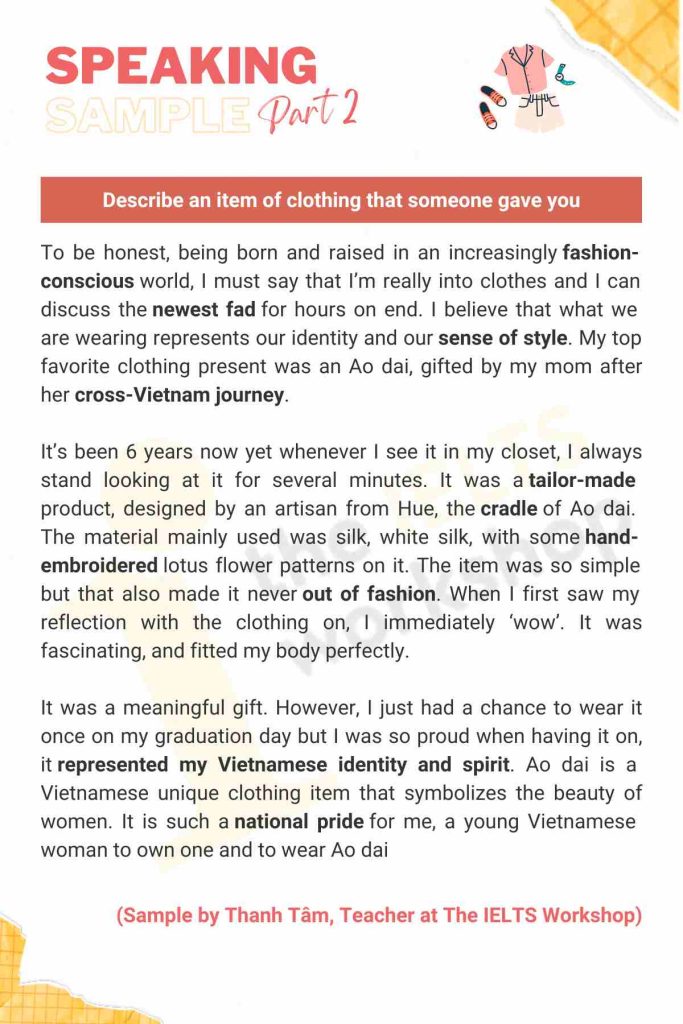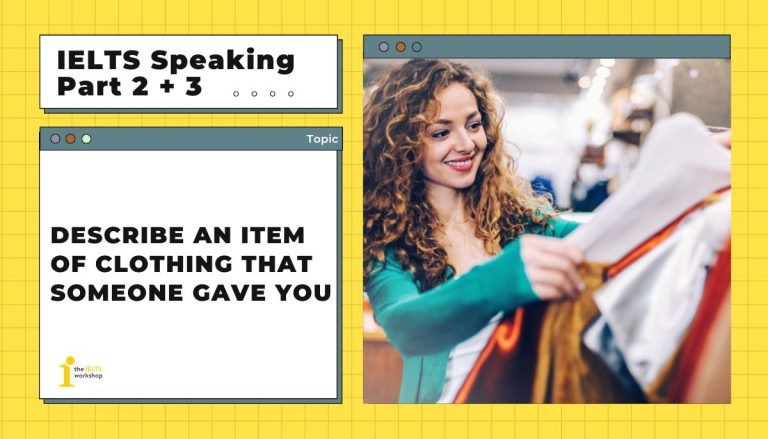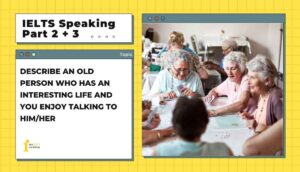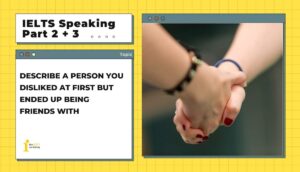Trong bài giải mẫu lần này, cô Thanh Tâm của The IELTS Workshop sẽ hướng dẫn bạn trả lời topic “Describe an item of clothing that someone gave you“ trong IELTS Speaking Part 2. Cùng tham khảo sample, từ vựng và một vài cách diễn đạt ghi điểm trong phần thi IELTS Speaking nhé.
Part 2: Describe an item of clothing that someone gave you
Describe an item of clothing that someone gave you
You should say:
What the clothing was
Who gave it to you?
When you got it
And explain why this person gave you the clothing
Dưới đây là bài mẫu cho topic “Describe an item of clothing that someone gave you“.
1. Bài mẫu (Sample)

2. Từ vựng (Vocabulary)
- fashion-conscious: yêu thích thời trang
- newest fad: xu hướng mới nhất
- sense of style: gu thẩm mỹ
- cross-Vietnam journey: hành trình xuyên Việt
- tailor-made: được may riêng
- cradle: cái nôi
- hand-embroidered: được thêu tay
- out of fashion: lỗi mốt
- represented one’s identity and spirit: đại diện cho bản sắc và tinh thần…
- national pride: niềm tự hào dân tộc
Part 3:
Bên cạnh Part 2, bạn hãy tham khảo thêm Part 3 cho chủ đề này nhé
Have you ever given clothes to someone?
Why do people from different countries wear different clothing?
What did you learn by the way of wearing someone else’s clothes?
Do you think Jeans and T-shirts are popular all over the world?
What about the advantages and disadvantages of wearing uniforms at work and school?
1. Have you ever given clothes to someone?
No, to be honest. As from my personal viewpoints, I reckon that each of us has a different taste for fashion so I’m afraid that it would not be to the reciever’s liking. In addition, there is plenty of information required when it comes to purchasing a piece of clothing such as sizes, heights and weights. However, I consider those things quite sensitive to ask so I usually go for other selections instead of clothes.
- have a taste for: thích
- to one’s liking: phù hợp
2. Why do people from different countries wear different clothing?
As far I’m concerned, this is due to 2 primary reasons, culture and climate. Cultural identity plays an important role in each’s decision of clothes. Therefore, we have the thing called national costume which represents the people of different countries. In addition, the climate condition of an area also affects the type of clothes that its residents choose to put on. For instance, it would not be ideal to wear a woolen sweater under the blazing sunshine of HCM City.
- blazing sunshine: nắng nóng
3. What did you learn by the way of wearing someone else’s clothes?
Well, that’s a tough one. I reckon that would be that person’s lifestyle. As we put on other’s clothes, we profoundly feel the differences like materials, style, which give us a glimpse of that person’s taste. Also, that would be a chance in which we temporarily inhabit another individual’s world and see what their life looks like and develop a sense of sympathy and connection with them.
- give a glimpse of sth: cho thấy 1 góc nhìn thoáng qua
- temporarily inhabit: trú ngụ tạm thời
4. Do you think Jeans and T-shirts are popular all over the world?
Yes, I do think so. It is considered a classic combo when it comes to an outfit. I believe that these items are easy to purchase and they usually come with an affordable price. Therefore, even those who are financially comfortable or low-income consumers can own such items. Also, it is a mix&match idea that fits in various situations from casual to formal as long as we know how to style our outfit.
- affordable price: giá cả phải chăng
- financially comfortable: dư dả tiền bạc
- mix&match idea: ý tưởng phối đồ
- as long as: miễn là
5. What about the advantages and disadvantages of wearing uniforms at work and school?
As regards to the pros, it is a way of fostering a sense of fairness in the working and educational environment. It represents the school and the business where people learn and work equally, contributing to their personal and professional growth as well as the institutions’ reputation. On the other hand, wearing uniforms might deter individuals from developing their uniqueness. For some people, clothing items represent their identity and personal sense of style. Being forced to wear the same clothes as others may make them less confident compared to when they make their decision freely.
- fostering a sense of fairness: thể hiện sự công bằng
- deter sb from doing sth: ngăn ai khỏi làm việc gì
Bài mẫu bởi cô Thanh Tâm – Giáo viên The IELTS Workshop
Các bạn có thể tham khảo Bộ đề dự đoán IELTS Speaking của The IELTS Workshop để ôn tập những chủ đề mới cho kỳ thi IELTS sắp tới của mình nhé!
Nếu bạn muốn nhận Mentor 1-1 để hoàn thiện kĩ năng Speaking của mình trước khi bước vào kỳ thi, tham khảo ngay Khóa bổ trợ từng kỹ năng IELTS của The IELTS Workshop.









